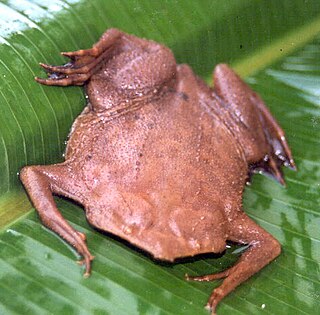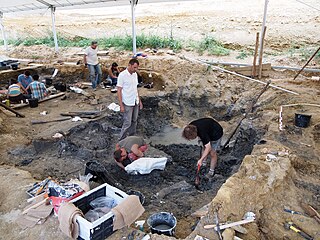
Sunnyodon is a genus of tiny, extinct mammal, probably of the Lower Cretaceous. Found in what is now southern England and Denmark, it was a relatively early member of the extinct order of Multituberculata. It is part of the suborder Plagiaulacida and family Paulchoffatiidae.

Echinodon is a genus of heterodontosaurid dinosaur that lived during the earliest Cretaceous of southern England and possibly western France in the Berriasian epoch. The first specimens were jaw bones named Echinodon becklesii by Sir Richard Owen in 1861, and since their original description only additional teeth have been discovered. The specific name honours collector Samuel Beckles who discovered the material of Echinodon and many other taxa from across England, while the genus name translates as "prickly tooth" in reference to the dental anatomy of the taxon.

Nuthetes is the name given to a genus of theropod dinosaur, likely a dromaeosaurid, known only from fossil teeth and jaw fragments found in rocks of the middle Berriasian age in the Cherty Freshwater Member of the Lulworth Formation in England and also the Angeac-Charente bonebed in France. If it was a dromaeosaurid, Nuthetes would have been a small predator.

The family Peramuridae is a family of mammals that lived in the Late Jurassic and Early Cretaceous. They are considered to be advanced cladotherians closely related to therian mammals as part of Zatheria.

Dryolestida is an extinct order of mammals, known from the Jurassic and Cretaceous. They are considered basal members of the clade Cladotheria, close to the ancestry of therian mammals. It is also believed that they developed a fully mammalian jaw and also had the three middle ear bones. Most members of the group, as with most Mesozoic mammals, are only known from fragmentary tooth and jaw remains.

Dryolestidae is an extinct family of Mesozoic mammals, known from the Middle Jurassic to the Early Cretaceous of the North Hemisphere. The oldest known member, Anthracolestes, is known from the Middle Jurassic Itat Formation of Western Siberia, but most other representatives are known from the Late Jurassic of North America and the Late Jurassic and Early Cretaceous of Europe. Most members are only known from isolated teeth and jaw fragments. Like many other groups of early mammals, they are thought to have been insectivores. They are generally classified in Cladotheria, meaning that they are considered to be more closely related to marsupials and placentals than to monotremes. They are placed as part of the broader Dryolestida, which also includes the Paurodontidae, and also sometimes the South American-Antarctic Meridiolestida, which are often considered unrelated cladotherians. Dryolestidae taxon is not based on a phylogenetic definition, but instead on the possession of unequal roots for the molars of the lower jaw. Additionally, the clade is distinguished by hypsodonty in lower molars, and uneven labio-lingual height for the alveolar borders of the dentary.

Cladotheria is a clade of mammals. It contains modern therian mammals and several extinct groups, such as the "dryolestoids", amphitheriids and peramurids. The clade was named in 1975 by Malcolm McKenna. In 2002, it was defined as a node-based taxon containing "the common ancestor of dryolestids and living therians, plus all its descendants". A different, stem-based definition was given in 2013, in which Cladotheria contains all taxa that are closer to Mus musculus than to the "symmetrodont" Spalacotherium tricuspidens.

Opisthias is a genus of sphenodont reptile. The type species, Opisthias rarus, is known from the Late Jurassic (Kimmeridgian-Tithonian) of western North America.
Paramacellodus is an extinct genus of scincomorph lizards from the Early Cretaceous of England and France, and the Late Jurassic of Portugal and the western United States. The type species, Paramacellodus oweni, was named in 1967 from the earliest Cretaceous (Berriasian) Purbeck Group in Dorset, England. Additional material referable to a species of Paramacellodus, possibly P. oweni, has been described from the Morrison Formation, specifically in Como Bluff, Wyoming, and Dinosaur National Monument, Utah. An indeterminate species is known from the Berriasian aged Angeac-Charente bonebed in France. Paramacellodus belongs to an extinct family of scincomorphs called Paramacellodidae, which spanned most of Laurasia during the Late Jurassic and Early Cretaceous and represented one of the earliest evolutionary radiations of lizards.

Paurodontidae is a family of Late Jurassic to Early Cretaceous mammals in the order Dryolestida. Remains of paurodontids have been found in the United States, Britain, Portugal, and Tanzania. The group likely represents a paraphyletic group of basal non dryolestid dryolestidans. Paurodon has been suggested to have been a specilast feeder on earthworms due to the morphology of its teeth closely resembling that of the golden mole genus Amblysomus.

Pipoidea are a clade of frogs, that contains the most recent common ancestor of living Pipidae and Rhinophrynidae as well as all its descendants. It is broadly equivalent to Xenoanura.

Henkelotherium is an extinct genus of dryolestidan mammal from the Late Jurassic (Kimmeridgian) Camadas de Guimarota, in Portugal. Unlike many other Jurassic mammals, it is known from a largely complete skeleton, and is thought to have had an arboreal lifestyle.
Donodon is an extinct genus of mammal from the Ksar Metlili Formation of Talssint, Morocco, which has been dated to the Late Jurassic to Early Cretaceous epochs. The type species D. perscriptoris was described in 1991 by the palaeontologist Denise Sigogneau-Russell. A second species, D. minor, was named in 2022. Donodon was a member of Cladotheria, a group that includes therian mammals and some of their closest relatives. It differed from dryolestids in having upper molars that were not compressed mesiodistally. Some studies have suggested that it was closely related to various South American cladotherians in the clade Meridiolestida, with specific similarities to Mesungulatum, a herbivorous mesungulatid, being noted. On the other hand, a 2022 phylogenetic analysis found it to be only distantly related to meridiolestidans, and instead closer to crown group therians.
Donodontidae is an extinct family of cladotherian mammals known from the Late Jurassic and Early Cretaceous of North Africa. When originally named in 1991, Donodontidae was a monotypic family containing a single species: Donodon perscriptoris. In 2022, four more species were designated and placed within the family: Donodon minor, Stylodens amerrukensis, Anoualestes incidens, and Amazighodon orbis. All five species are endemic to the Ksar Metlili Formation of Morocco, which is dated to the Tithonian and Berriasian. Donodontid fossils are restricted to postcanine teeth and associated jaw fragments.

The Oulad Abdoun Basin is a phosphate sedimentary basin located in Morocco, near the city of Khouribga. It is the largest in Morocco, comprising 44% of Morocco's phosphate reserves, and at least 26.8 billion tons of phosphate. It is also known as an important site for vertebrate fossils, with deposits ranging from the Late Cretaceous (Cenomanian-Turonian) to the Eocene epoch (Ypresian), a period of about 25 million years.

Meridiolestida is an extinct clade of mammals known from the Cretaceous and Cenozoic of South America and possibly Antarctica. They represented the dominant group of mammals in South America during the Late Cretaceous. Meridiolestidans were morphologically diverse, containing both small insectivores such as the "sabretooth-squirrel" Cronopio, as well as the clade Mesungulatoidea/Mesungulatomorpha, which ranged in size from the shrew-sized Reigitherium to the dog-sized Peligrotherium. Mesungulatoideans had highly modified dentition with bunodont teeth, and were likely herbivores/omnivores. Meridiolestidans are generally classified within Cladotheria, more closely related to living marsupials and placental mammals (Theria) than to monotremes, barring one study recovering them as the sister taxa to spalacotheriid "symmetrodonts". However, more recent studies have stuck to the cladotherian interpretation. Within Cladotheria, they have often been placed in a group called Dryolestoidea together with Dryolestida, a group of mammals primarily known from the Jurassic and Early Cretaceous of the Northern Hemisphere. However, some analyses have found this group to be paraphyletic, with the meridiolestidans being more or less closely related to therian mammals than dryolestidans are. Meridiolestidans differ from dryolestidans in the absence of a parastylar hook on the molariform teeth and the lack of a Meckelian groove.
The Ksar Metlili Formation is a geological formation in eastern High Atlas of Morocco, it is late Tithonian to Berriasian in age. It is approximately 80 metres (260 ft) thick and primarily consists of mudstone and sandstone, with thin calcareous beds. One of these calcareous beds near the middle of the sequence is an important microvertebrate locality. Subsequent to the original site, several other localities have been sampled. The depositional environment is thought to be near shore deltaic.
Spalacotherium is a genus of extinct mammal from the Early Cretaceous of Europe. The type species Spalacotherium tricuspidens was originally named by Richard Owen in 1854, and its material includes maxillary and dentary fragments and many teeth from the Berriasian Lulworth Formation of southern England. Referred species include S. taylori, S. evansae and S. hookeri also from the Lulworth deposits, and S. henkeli from Barremian deposits of Galve, Spain. The Lulworth taxon Peralestes longirostris, named by Owen in 1871, is a junior synonym of the type species S. tricuspidens. Spalacotherium is the namesake taxon of the family Spalacotheriidae, which is an extinct clade within Trechnotheria that may be closely related to the Gondwanan clade Meridiolestida, or united with the family Zhangheotheriidae to form Symmetrodonta.S. evansae is also from the Berriasian aged Angeac-Charente bonebed in western France.
Thereuodon is a genus of extinct mammal known from the Early Cretaceous of southern England, Morocco and France. The type species, named by Denise Sigogneau-Russell in 1989 for teeth from the earliest Cretaceous Ksar Metlili Formation of Morocco, is Thereuodon dahmani, while the referred species named by Sigogneau-Russell and Paul Ensom for teeth from the Lulworth Formation of England is Thereuodon taraktes. The two species are separated by a break in the cingulum in T. dahmani, a more obtuse medial crest in T. taraktes, a duller stylocone in T. taraktes, a "c" cuspule in T. dahmani, and a reduced facet A in T. taraktes. The genus Thereuodon is the only taxon in the symmetrodont family Thereuodontidae, which may be closely related to Spalacotheriidae. A tooth referred to T. cf. taraktes is known from the Berriasian aged Angeac-Charente bonebed of France.

The Angeac-Charentebonebed is a fossil deposit located near Angeac-Charente in western France. It dates to the Berriasian stage of the Early Cretaceous, and is coeval with the Purbeck Group of Southern England. It has amongst the most diverse assemblages of earliest Cretaceous vertebrates known from Europe.


















